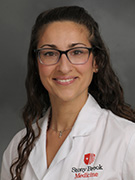Nearly half of all women over 40 have dense breast tissue, which can make it more challenging to detect breast cancer through standard mammograms.
Mammography remains a vital tool for early detection, and additional imaging options – like breast ultrasound – may be recommended to ensure the most accurate results for women with dense breasts.
What Are Dense Breasts?
Breast density describes the ratio of different types of tissues within the breast. Dense breasts have less fatty tissue and more non-fatty tissue (called fibroglandular tissue) compared to breasts that aren’t dense. There are four categories of breast density, ranging from almost all fatty tissue to extremely dense tissue with very little fat.
Having dense breasts is actually physiologic, present in about 50 percent of women over the age of 40 to some degree. However, having dense breasts can make it harder to detect cancers in mammograms because both dense tissue and tumors appear white on an X-ray, making the tumor less noticeable.
How to Know If You Have Dense Breasts
Dense breasts can only be identified through a mammogram by a radiologist. Density can not be felt, including during a self-exam, and it doesn’t affect breast size.
Women are often informed by their healthcare provider if their mammograms indicate dense breasts, as this affects the screening process. In September 2024, the FDA began requiring healthcare providers to notify patients about the density of their breasts following mammograms in order to increase their awareness of their risk factors.
Women in their reproductive years are more likely to have dense breasts, and density usually declines over time with age.
What’s the Connection Between Dense Breasts and Cancer?
Dense breast tissue can make it more difficult to identify breast cancer on a mammogram, especially if the breasts are very dense.
This increased risk is thought to be related to the fact that dense tissue can hide small tumors on mammograms, as both appear white on the image, making it harder to spot abnormalities. For this reason, women with very dense breasts are more likely to be called back for additional imaging due to inconclusive mammogram results.
While mammography is still the primary screening tool, supplemental imaging tests like breast ultrasound or MRI may be recommended for women with dense breasts to improve cancer detection.
New Screening Guidelines for Breast Cancer
The U.S. Preventive Services Task Force (USPSTF) has updated its recommendations for breast cancer screening, now advising that all women should have a screening every other year starting at age 40 through 74. While the USPSTF previously recommended screening starting between the age of 40 and 50, they now recommend screening begins for all women at age 40.
This updated recommendation reflects the increasing rates of breast cancer among women in their 40s and emphasizes the significant potential for saving more lives through earlier screening. There’s also a special note that Black women, who face higher risks for breast cancer, can benefit significantly from this early start.
Additional Screening Recommendations for Dense Breasts
For women with dense breasts, additional screening beyond standard mammograms may be necessary.
Options for screening dense breasts can include:
- 3D mammography (tomosynthesis), which can provide clearer results in dense breast tissue.
- MRI and ultrasound screenings, which do not rely on radiation and can sometimes detect abnormalities that mammograms might miss. These studies should not be done in lieu of a mammogram.
It’s advised that women with dense breasts discuss additional diagnostic options with their healthcare providers to ensure effective screenings.
At Stony Brook Cancer Center, women with dense breasts receive specialized care tailored to their unique needs. Our team is committed to providing the most effective screening options, including the use of advanced imaging technologies that might benefit women with dense breast tissue. We encourage women to consult with our experts to understand their specific risks and screening options.












